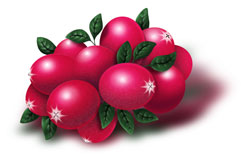There’s nothing like the sweet and bitter taste of cranberry. Cranberry Facts and fun trivia just don’t do justice to overall joy it can bring recipes and drinks.
But here are some cranberry facts you can use to impress your teacher:
- The Cranberry plant is a close relative of the blueberry and the bilberry. These plants are in the Ericaceae family.
- Cranberries are a good source of resveratrol – which is found in blueberries, bilberries, peanuts, yucca, grapes and japanese knotweed.
- The pilgrims learned about cranberries from the Native American Indians (the true pioneers of herbal medicines).
- The scientific name of cranberries is Vaccinium macrocarpon.
Nutrients in Cranberries
| Cranberry Facts: Nutrients
Cranberries are a great source of anti-carcinogenic (cancer fighting) antioxidants like resveratrol,oligomeric proanthocyanidinds (OPC’s), Vitamin C, and Vitamin K. Cranberries also contain fiber, phytochemicals, manganese, Niacin, Choline, calcium, phosphorus, potassium, sodium, Vitamin A, and beta-carotene. |
Cranberries and Acidity

Cranberries contain Hippuric and Quinic acids – which helps to break up and prevent kidney stones. They also fight harmful bacterias and play a role in preventing bacteria from sticking the cell walls in the body.
It was once believed that the acid caused the urine to be acidic and thus prevented bacteria from living there. But more recent evidence shows the nutrients in cranberries prevent the bacteria from sticking the cell walls.
Click to read more cranberry facts regarding their ability to help Urinary Tract Infections.
Cranberry Fun Facts (From OceanSpray)
Cranberry Fun Facts
- The cranberry is one of only a handful of major fruits native to North America. Others include the blueberry and Concord grape.
- The cranberry gets its name from Dutch and German settlers, who called it “crane berry.” When the vines bloom in the late spring and the flowers’ light pink petals twist back, they have a resemblance to the head and bill of a crane. Over time, the name was shortened to cranberry.
- During the days of wooden ships and iron men, American vessels carried cranberries. Just as the English loved limes, American sailors craved cranberries. It was the cranberry’s generous supply of vitamin C that prevented scurvy.
- Native Americans used cranberries to make a survival cake known as pemmican. They also used the fruit in poultices and dyes.
- Dennis, Massachusetts was the site of the first recorded cranberry cultivation in 1816.
- American recipes containing cranberries date from the early 18th Century.
- Legend has it that the Pilgrims may have served cranberries at the first Thanksgiving in 1621 in Plymouth, Massachusetts.
- During World War II, American troops required about one million pounds of dehydrated cranberries a year.
Sign Up Now and Get a Free eBook on the Health Benefits of Cranberries
- The hearty cranberry vine thrives in conditions that would not support most other crops: acid soil, few nutrients and low temperatures, even in summer.
- It takes one ton or more of cranberry vines per acre to plant a bog.
- Depending on the weather, cranberry blossoms last 10 to 12 days.
- Contrary to popular belief, cranberries do not grow in water. They are grown on sandy bogs or marshes. Because cranberries float, some bogs are flooded when the fruit is ready for harvesting.
- If all the cranberry bogs in North America were put together, they would comprise an area equal in size to the tiny island of Nantucket, off Massachusetts, approximately 47 square miles.
- Cranberries are primarily grown in five states — Massachusetts, Wisconsin, New Jersey, Oregon and Washington. Another 5,500 acres are cultivated in Chile, Quebec, and British Columbia. There are nearly 1,000 cranberry growers in America.
- The 1996 harvest yielded more than 200 billion cranberries — about 40 for every man, woman and child on the planet.
- In 1996, cranberry growers in the United States harvested 4.84 million barrels of fruit, according to the U.S. Department of Agriculture. End to end, that many berries would span more than 1.75 million miles.
- Did you know that there are 440 cranberries in one pound? 4,400 cranberries in one gallon of juice? 440,000 cranberries in a 100-pound barrel?
- Americans consume some 400 million pounds of cranberries each year. About 80 million pounds — or 20 percent — are gobbled up during Thanksgiving week.
- Seven of 10 cranberries sold in the world today come from Ocean Spray, a grower cooperative started in 1930.
- If you strung all the cranberries produced in North America last year, they would stretch from Boston to Los Angeles more than 565 times.
- Cranberries are sometimes used to flavor wines, but do not ferment as naturally as grapes, making them unsuitable for the traditional winemaking process.
| Used with permission from Ocean Spray Cranberries, Inc.Copyright ©2000 Ocean Spray Cranberries, Inc. All Rights Reserved. |